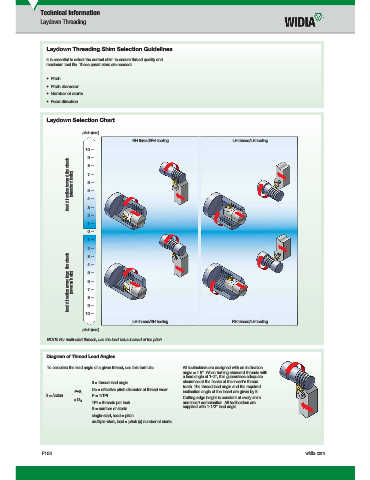Page 730 - Master Catalog 2017, Inch
P. 730
Technical Information
Laydown Threading
Laydown Threading Shim Selection Guidelines
It is essential to select the correct shim to ensure thread quality and
maximum tool life. These parameters are needed:
• Pitch
• Pitch diameter
• Number of starts
• Feed direction
Laydown Selection Chart
pitch (mm)
RH thread/RH tooling LH thread/LH tooling
10 —
9 —
feed direction toward the chuck (standard helix) 7 —
8 —
6 —
5 —
4 —
3 —
2 —
1 —
0 —
1 —
2 —
feed direction away from the chuck (reverse helix) 5 —
3 —
4 —
6 —
7 —
8 —
9 —
10 —
LH thread/RH tooling RH thread/LH tooling
pitch (mm)
NOTE: For multi-start threads, use the lead value instead of the pitch.
Diagram of Thread Lead Angles
To calculate the lead angle of a given thread, use this formula: All toolholders are designed with an inclination
angle = 1.5°. When turning standard threads with
a lead angle of 1–2°, this guarantees adequate
ß = thread lead angle clearance at the fl anks of the insert’s thread
tooth. The thread lead angle and the required
De = effective pitch diameter of thread wear
P•S inclination angle of the insert are given by ß.
ß = Arctan P = 1/TPI
/ D e Cutting edge height is constant at every shim
TPI = threads per inch and insert combination. All toolholders are
supplied with 1-1/2° lead angle.
S = number of starts
single-start, lead = pitch
multiple-start, lead = pitch (x) number of starts
F104 widia.com
WID M
F104 F105 Mi
i
16 T
Th
i
di
V
L WID_Master16_Turning_Threading_F104_F105_Minch_REBRAND.indd 104 h REBRAND N b 9 2015 4 08 PM 11/12/15 4:31 PM

